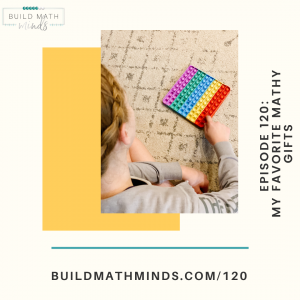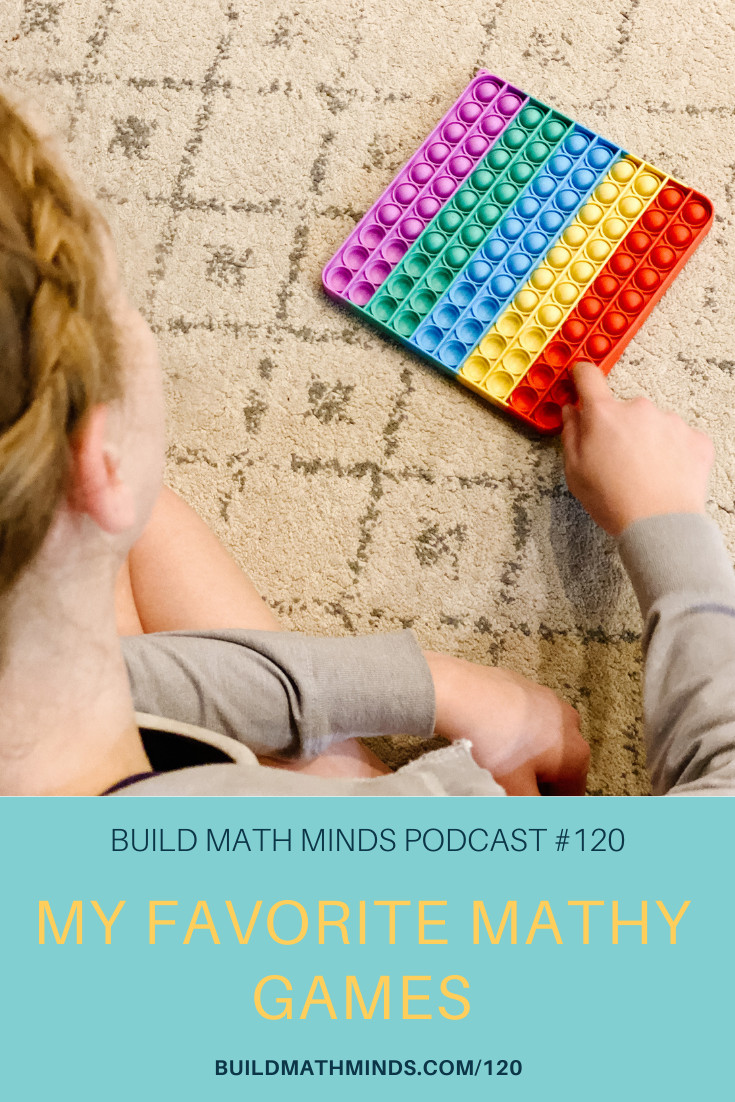Resources mentioned in this episode:
Math4Love Games by Dan Finkel
Osmo – Genius Starter Kit
Zingo: 1-2-3 Number Bingo
Welcome fellow Recovering Traditionalists to Episode 120. Today we are taking a look at My Favorite Mathy Gifts for 2021.
As we near the holiday season, many people are looking for gifts. I like to give math-based gifts but they are a lot harder to find than reading-based gifts. It’s super easy to find lots of books that are great to give kids (or my teacher friends). So if you are like me and would like to give a math-y gift instead of a reading gift, I thought I’d share a few of my favorites for 2021.
I only like to share things that I have personally used, so if I don’t mention your favorite, come over to the comments on the show notes page to let me know what I should try out. Just go to buildmathminds.com/120 to add your comment, or share about this episode on social media and tag me with a math-y gift you think I should check out.
My first recommendation is any game from my friend Dan Finkel over at Math4Love. He is the creator of Prime Climb, Tiny Polka Dots, and he recently created Multiplication by Heart. You can’t go wrong with any of these. Prime Climb and Tiny Polka Dots are fun and engaging games. Multiplication by Heart has been interesting to see how my 3rd and 5th grader think about multiplication. For those of you who are members of the Build Math Minds PD site, you have access to two mini courses that Dan did about using games in the classroom in PreK-2 and in 3rd-5th.
A favorite game in our house is Wits & Wagers, so much so that the kids would play it without Mom & Dad and have lost too many pieces and we can’t play it anymore. I recently saw they have a new version of it called the Vegas Edition and one of my kids is getting that game this year…good thing my kids don’t listen to my podcast. The thing I love about this game is that it’s all questions that nobody knows the actual answer to, but guessing the answers helps build kids’ number sense and estimation. You get questions like “on average, how many original-flavor Pringles come in a standard-sized can?” Each person uses their Wits to make their guess and then everyone places their Wager on whose guess they think is actually the closest.
Osmo is an accessory that can be used with an iPad or a Kindle. I got it for my kids back when Osmo first started and they loved it. It has since evolved and gotten even better. I saw the Osmo Genius Starter Kit on Amazon that has most of the activities that we purchased individually back in the day, but there are so many other variations. The Genius kit has number tiles, subizing tiles, and tangrams and the activities in Osmo that you use those pieces for are mathematically sound and easy for the kids to do on their own and work through solving without much help from an adult.
Zingo is one that I haven’t played but as I was working on this podcast my youngest son asked what I was working on and he gave me his favorite game which is Zingo: 1-2-3 Number Bingo. One of his past teachers used it in school and he still remembers it. When I looked it up, there are a few different Zingo games, but the number version looks like it has subitizing images on the bingo boards, which I love to see.
We love to play card games in my family, but as I started learning about how kids build number sense, I didn’t really like using regular playing cards with my young kids. Playing cards really only build a kids’ number identification skills. They learn to recognize the numerals on the cards. Yes, there are visuals on the cards, but they are incorrect visuals. For example, when a kid has the 4 of hearts, they actually see 6 hearts on the card. So, I created a deck of cards I call Savvy Subitizing Cards. These cards have 6 different variations of every quantity 0-10. The cards show each number with the numeral, in a ten frame, finger patterns, dot patterns, on a rekenrek, and tally marks. You can use the cards in place of a regular deck of cards for so many of the traditional card games we play and they help kids build visual representations of the quantities as they play.
The last mathy gift doesn’t really fit the mold, but hear me out: Pop-Its…yes the fidget toy that drives parents and teachers crazy, can also be a great mathy toy. I bought one that was set up like a game, where you roll dice and each player then pops the amount they rolled. That’s an obvious math connection, but you don’t need to buy that kind of pop-it for kids to do math concepts. If you get any of the square-style pop-its, it’s basically an array. Kids can just count, they can make patterns, but you can also create arrays inside the pop-it. The image I’m sharing on social media for this podcast is actually a picture of my 7th grade daughter playing with her pop-it. It’s a 10×10, with two rows of ten of 5 different colors. She has ‘popped’ 3 in each row. So essentially she has 10 groups of 3 popped. But the way it’s set up, kids might see it in lots of different ways. By asking how many are popped, you open up the conversation to hear how they see it. Your child might count every single circle that is popped. They might see groups of 3, or groups of 2, or even 2 groups of 3…which they might just say as 6. A free-form toy like Pop-its can be a great springboard for lots of mathematical ideas.

Lots of things can become mathematical just by the questions we ask kids while they are playing. If you want to buy a mathy gift, those I mentioned are some of my favorites right now, but if you don’t or can’t buy gifts, I just want to encourage you to let kids play to experience math concepts and that can be done without formal math games.
If you like what you have been hearing there are a few ways I would love for you to let me know. The first way is to subscribe to the podcast. If you are listening in iTunes make sure to hit that subscribe button. Also in iTunes I would love for you to leave a review and let me know if you are enjoying the podcast which types of episodes are your favorite. Really just anything to get me feedback about the show and lastly if you are on Instagram or Twitter I would love for you to share when you listen to an episode that you love. Make sure you tag me @buildmathminds and all of those are the ways to let me know that there are actually people out there listening. Thank you so much for letting me be a small part of your math journey
Subscribe and Review in iTunes
While you’re there, don’t forget to leave a review on iTunes too. I would love to know your thoughts and how we can make sure that we give you content that you will really enjoy.
To leave a review, head over to iTunes and click on “Ratings and Reviews” and “Write a Review.” I can’t wait to hear your thoughts about the podcast.




